![]()
![]()
![]()
Use LEFT and RIGHT arrow keys to navigate between flashcards;
Use UP and DOWN arrow keys to flip the card;
H to show hint;
A reads text to speech;
39 Cards in this Set
- Front
- Back
|
Prehistoric |
c. 2.5 million years ago to 2000 bce
Paleolthic: 200,000 bce to 15,000 bce Neolithic: 12,000 bce to 2,000 bce All humans before writing. Art was for documentation and utilitarian purposes. Cave drawings, weapons, pots. |
|
|
Egypt |
5000 bce to 30 bce
Old Kingdom: 2649 to 2150 bce Middle Kingdom: 2030 to 1640 bce New Kingdom: 1550 to 1070 bce
Northern Africa with agricultural success from Nile. Consisted of strict conventions that artists must follow. Akhenaten briefly changed conventions with stylized representations and physical distortions, but his son restored them. Known for great funerary traditions, including tombs and pyramids. Art based around rulers and dieties. |
|
|
Ancient Near East |
4000 bce to 330 bce
Sumer: 3000 to 2350 bce Akkad: 2350 to 2150 bce Assyria: 900 to 600 bce Persia: 550 to 330 bce
Mainly in around the Fertile Crescent and Mesopotamia, between the two Rivers Euphrates and Tigris. Invented cuniform. Religion played a big part in the peoples of the Near East, can be seen with the impressive ziggurats with temples on top. |
|
|
Aegean |
6000 bce to 1200 bce
Cycladic: 6000 to 2000 bce Minoan: 2000 to 1350 bce Mycenean: 1700 to 1200 bce Geography included the Cyclades, Crete, Mycenae, and mainland greece. Travelled and traded by sea. Palaces with a big central space. Columns that tapered at the bottom. |
|
|
Greece |
900 bce to 30 bce
Geometric: 900 to 750 bce Orientalizing: 750 to 600 bce Archaic: 600 to 480 bce Transitional: 500 to 480 bce Classical: 480 to 323 bce Early classical: 480 to 450 bce High classical: 450 to 400 bce Late classical: 400 to 323 bce Hellenistic: 323 to 30 bce Mainland Greece, but Mediterranean Sea helped spread influence to Peloponnese, Macedonia, and Aegean islands. Repetition of Geometric forms on pottery and abstracted human forms during Geometric period. But then human portrayl turned more realistic in archaic period. Painted pots then featured Black and red figure styles. In the classical period after the victory of Persians, Greeks built the Parthenon and more realistic human figures, sporting contrapposto posture and slightly exaggerated proportions. Alex the Great spread the influence. |
|
|
Etruscan |
700 bce to 100 bce Located in central Italy, Etruscans drew inspiration from Greek and Near Eastern art. Elaborate tombs chambers |
|
|
Roman |
753 to 400 bce Republic Early empire High empire: 96-193 CE Late empire: 193- 363 CE
Took over Etruscans and borrowed Etruscan and Greek culture, style, and even gods, not before changing their names. Portraiture contained wrinkles and imperfections to show the most realistic representation. Mastered arches and the dome in architecture, seen in the aqueducts and Pantheon. |
|
|
Late Antique |
300 to 700 ce |
|
|
Byzantine |
330 to 1453 ce |
|
|
Byzantine |
Unknown yet |
|

|
Nude Woman (Venus of Willendorf)
Paleolthic Limestone
Exaggerated female forms and no face. Expressing general fertility and health (well-fed). Small, would be held or carried. |
|

|
Aurochs, horses, and rhinoceroses
Chauvet cave Paleolthic Wall painting
Documentation pruposes. Aurochs are in composite view to show both horns, give information on animal. Could also be religion based, bc deep in cave, inaccessible. |
|
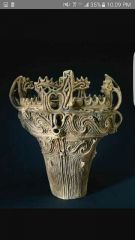
|
Flame style vessel
Neolithic (jomon period) Earthenware Jomon period excelled in ceramics. This piece could be utilitarian, for cooking or transporting. The ornate coil detailing on top shows that this was not used to drink from. Pots were used in ceremonies. |
|
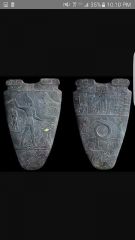
|
Palette of Narmer
Early dynastic Slate Represents the unification of Upper and Lower Egypt. Use of hierarchic scale to show importance of Narmer. Horus is present above defeated opponent and Bat is on top, showing religious practice/oversight. Conventions of composite view and registers are seen. Circular depression for makeup |
|
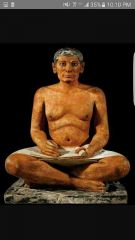
|
Seated scribe
Old Kingdom Egypt Painted limestone Distinction of class levels are highlighted with this figure. Seated instead of standing like kings. Rolls on stomach and narrow shoulders instead of muscular depiction like kings. Also shows that he is well fed so not low class. |
|
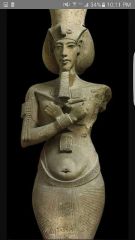
|
Colossal Statue of Akhenaten
New Kingdom Egypt Sandstone Shows the shift in religion under Akhenaten's rule. Did not follow muscular depiction/convention. More feminine, hourglass figure. This androgynous depiction may come from the introduction of sexless sun god Aten, that Akhenaten introduced. |
|
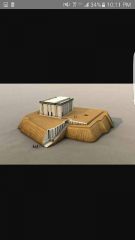
|
White Temple and Anu Ziggurat
Uruk Sumerian - Near East White washed, mud-brick temple. Simple design of rectangular temple with an altar and small places, with God statues within |
|
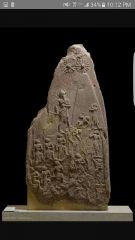
|
Victory Stele of Naram-Sin
Akkadian - Near East Limestone |
|
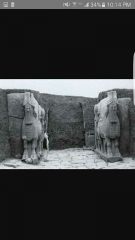
|
Guardian Figures (Iamassu)
Citadel of Sargon II Assyrian- Near East Stone 5 legged to activate creature when walking passed it. Paved at entry ways to guard palaces. Hybrid creature |
|

|
Female Figure
Cycladic- Ancient Aegean Marble Nude Woman, as the majority of sculptures depicted. Had conventions of strict symmetry. Arms folded under breasts. Elongated neck. No individuality of face. Likely had paint decoration. Handheld, not statue |
|
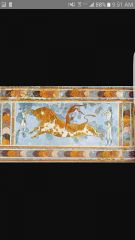
|
Bull Leaping
From Knossos Minoan- Ancient Aegean Fresco Men who spend a lot of time out side are darker. Women are painted white. Very stylized human forms, with pinched waists. Thought to be representing an initiation or fertility ritual. |
|

|
Harvester Vase
Minoan- Ancient Aegean Steatite Of ritual significance. Figures occupying 3D space bc they're overlapping. Near East and Egyptian are has ppl in single file. Figures are happy, singing and shouting. You can see the ribs of one of the men, showing accuracy in anatomy. |
|

|
Lion Gate at Mycenae
Mycenean- Ancient Aegean Limestone Above a post and lintel structure. Guardian beasts. Typical Minoan column, with column that swells upward with large capital. Lions are metaphor for power. |
|
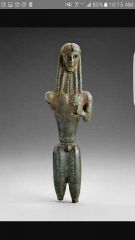
|
Mantiklos "Apollo"
Late Geometric/ Early Orientalizing-Greece Bronze |
|
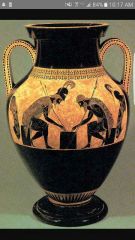
|
Ajax and Achilles playing a dice game Exekias
Archaic- Greece Black figure amphora Based on its size and shape, this amphora is thought to be a storage jar. Shows the heroic warriors Ajax and Achilles playing a dice game, while leaning on their spears. No gods or kings. Human supremacy found in all Greek art. |
|
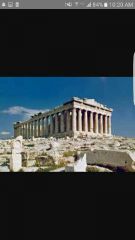
|
Parthenon (Temple of Athena Parthenos) Iktinos and Kallikrates Athens High Classical- Greece architecture and decoration Harmony and balance with 4:9 ratio. In both breadth and length,and column diameter to space between. Refinements of columns to correct optical illusions. Sculptural decorations convey the triumph of the Democratic Greek city states over imperial Persia. Processional frieze, procession every 4 years. Sense of pride in the body of people. |
|

|
Model of a 6th century BCE temple Etruscan |
|

|
Sarcophagus of the spouses
painted terracotta |
|
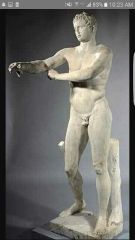
|
Apoxyomenos (Scraper) Lysippos
Late Classical marble
This shows the very realistic style of the Late Classical period, with subtly exaggerated proportions and youth to be idealized. We can also see a conceptual shift in the art, as this is portraying a mundane activity of scraping off dirt. This makes the figure that more human. Limbs outstretched, breaking the surrounding space, inviting the viewer to enter the space and move around the statue |
|
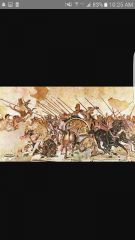
|
Battle of Issus (Alexander Mosaic) Roman copy of Greek Late Classical/Hellenistic painting mosaic Depicting a fight between Alexander the Great and a Persian leader. Hierarchy can be seen in the eye contact between the two leaders. |
|
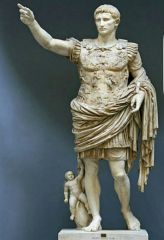
|
Portrait of Augusta as General (Primaporta Augustus) Early Empire Marble copy of bronze original |
|
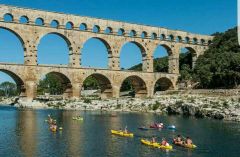
|
Pont du gard outside Nimes, France (Roman Gallia) early Empire |
|
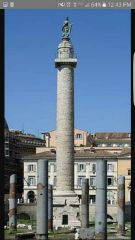
|
Column of trajan
Rome high Empire |
|
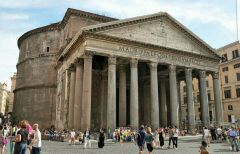
|
Pantheon Rome High empire |
|
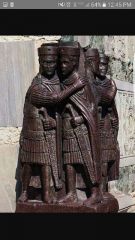
|
Four tetrarchs Late empire Porphyry |
|
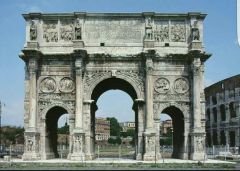
|
Arch of Constantine Rome Late empire/late Antique |
|
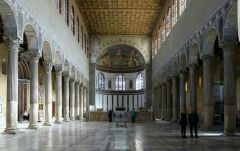
|
Santa Sabina Rome Early Christian/Late Antique |
|

|
Sarcophagus of Junius BassusEarly Christian/Late Antique Marble |
|
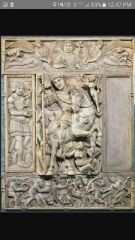
|
Justinian as world conqueror (Barberini Ivory) Byzantine Ivory |

